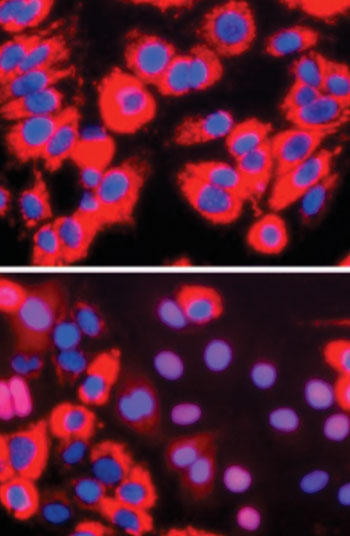DNA Found That Enables Growth of Wild-Type Hepatitis C Virus in Cell Cultures
By LabMedica International staff writers
Posted on 01 Sep 2015
A team of molecular virologists has found that the overexpression of a particular DNA in liver cancer cells enables these cells to maintain the growth of wild-type Hepatitis C virus (HCV) in culture.Posted on 01 Sep 2015
Since its discovery in 1989, efforts to grow clinical isolates of HCV in cell culture have met with limited success. Only the JFH-1 isolate has the capacity to replicate efficiently in cultured liver cells without first undergoing cell culture-adaptive mutations.

Image: Researchers engineered cultured cells to contain a red marker that moves into the nucleus upon HCV infection. Nothing happened when normal cells were exposed to HCV (top), but when the researchers expressed the protein SEC14L2, some nuclei changed color from blue to purple (bottom) (Photo courtesy of Laboratory of Virology and Infectious Disease at The Rockefeller University).
Investigators at The Rockefeller University (New York, NY, USA) hypothesized that cultured cells lack one or more factors required for the replication of clinical isolates. To identify these factors, the investigators used a pooled Lentivirus-based human complementary DNA (cDNA) library to transfect cultures of liver cancer cells with HCV subgenomic replicons lacking any adaptive mutations, and then selected for stable replicon colonies.
Results from screening more than 7,000 human genes by this process were published in the August 12, 2015, online edition of the journal Nature. They revealed the identification of a single cDNA, SEC14L2, which enabled RNA replication of diverse HCV genotypes in several liver cancer cell lines. This effect was dose-dependent and required the continuous presence of SEC14L2.
Remarkably, SEC14L2-expressing liver cancer cells also supported HCV replication following inoculation with patient sera. Mechanistic studies suggested, and the investigators speculated, that SEC14L2 promoted HCV infection by enhancing vitamin E-mediated protection against lipid peroxidation.
"Being able to easily culture HCV in the lab has many important implications for basic science research," said senior author Dr. Charles M. Rice, professor of virology at The Rockefeller University. "There is still much we do not understand about how the virus operates, and how it interacts with liver cells and the immune system."
Related Links:
The Rockefeller University














